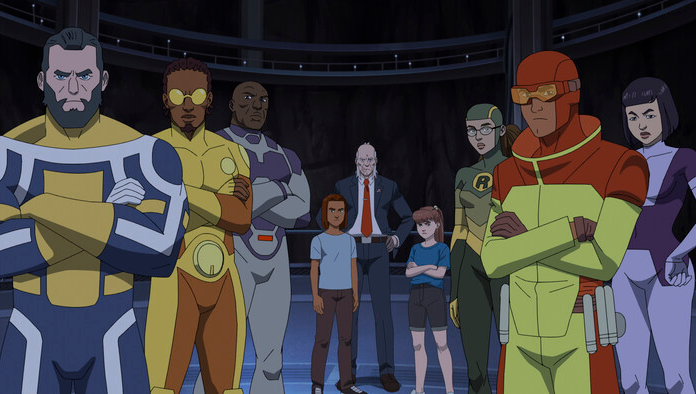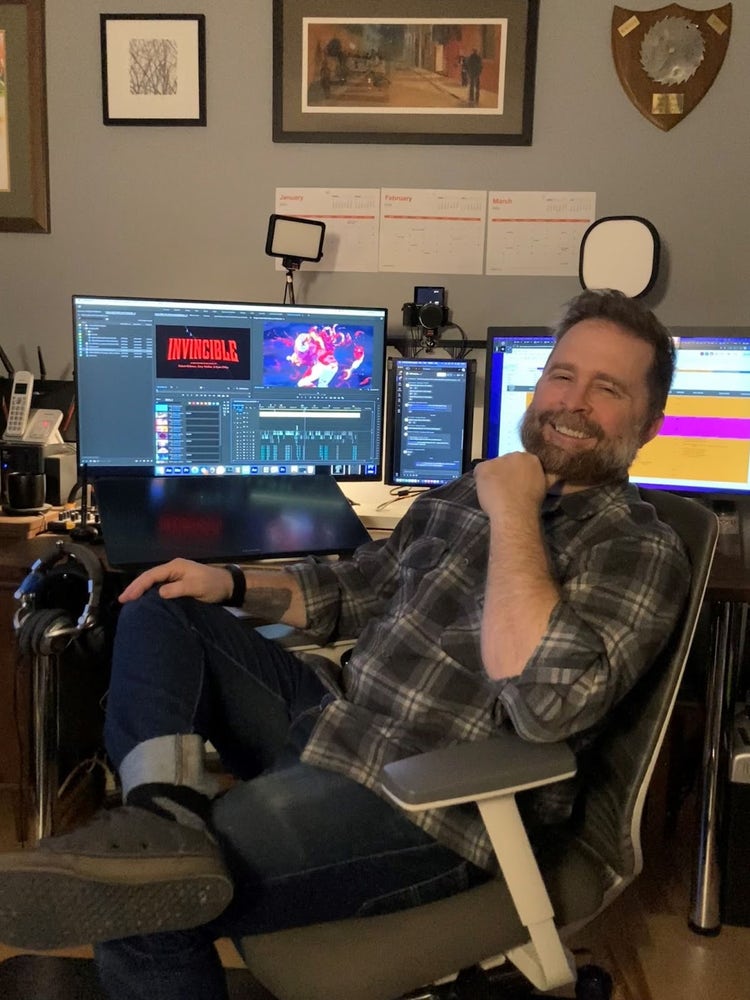Editing Prime Video's “Invincible” on Premiere Pro with supervising editor Luke Asa Guidici

Prime Video's “Invincible” is an animated series packed with superstars voicing superheroes. But the real superheroes behind it all are the folks at Skybound Entertainment, the entertainment company that created the series. Skybound has been creating universes that transport and transfix audiences since 2010, and we’re honored that they rely on Adobe Creative Cloud tools such as Premiere Pro, After Effects, and Photoshop, to bring their incredible worlds to life.
Hear from “Invincible’s” supervising editor Luke Asa Guidici below as he dives into his career, specific challenges the team faced on this VFX-heavy series, and how tools like Premiere Pro Productions and tricks like keyboard customizations keep him organized.
Season 2, Part 1 of “Invincible” is streaming now on Prime Video. Part 2 streams on March 14.
How and where did you first learn to edit?
I got my first taste of editing in a high school TV production class, which inspired me to pursue a career in film. After graduating, I sold my car and used the money to build my first editing system. Then, in college, I tried to take as many classes as I could that let me make work, and through that process I learned a lot, not just about editing but also troubleshooting, hardware/software conflicts, and collaboration. I also interned for a talented documentary filmmaker and editor named Bob Sarles who gave me my first "professional" credit — and has been a source of guidance and wisdom throughout my career.
How do you begin a project/set up your workspace?
The first thing I do is rewire everything. Seriously. Most editing bays I've gone into are a rat's nest of unlabeled cables...and not having a well-organized workspace really bothers me. As far as a project goes, I suppose my method is similar, I think about the various media/assets the project will use and begin to build the organizational structure that will best support that. I don't want any of my assistants or editors to have to hunt around for where media lives — it should all be intuitive.
Tell us about a favorite scene or moment from this project and why it stands out to you.
Oh man, that's hard to pick — there are so many great moments in “Invincible”. The show does an amazing job balancing action, drama, and comedy. There are frenetic moments of extreme brutality, and quiet moments of tender humanity. I think the episode "The Missive, This Machination" showcases this wonderfully. There is a "support group" scene where Debbie (Sandra Oh) and the group leader have this beautiful, small, touching interaction. Then later in this episode, Allen the Alien (Seth Rogen) gets absolutely beaten to a pulp in a brutal zero-g fight with three Viltrumites — a blood-thirsty, genocidal race bent on controlling the galaxy. So, a big contrast in content and tone in the same episode.
What were some specific post-production challenges you faced that were unique to your project? How did you go about solving them?
We do a lot of internal retakes and VFX work. We'll often be using a combination of assets drawn by our supervising directors (Dan Duncan & Shaun O'Neil), assets from the art department, and the animation done by our overseas studios. Developing the workflow to ensure that assets were tracked properly, color space was maintained, and files were prepped correctly for color correction was tricky, but with the help of our lead assistant editor, Liam Johnson, and our VFX editor, Samantha Schnauder, we have been able to implement a solid system.
What Adobe tools did you use on this project and why did you originally choose them? Were there any other third party tools that helped enhance your workflow?
We use Premiere Pro, After Effects, and Photoshop. For this job, I was especially excited about the Production feature [in Premiere Pro]. Using that I was able to organize our workflow and assets so that we could have three editors and two assistants all working at the same time. The third-party tool I use most often is probably my AeroPress... which reminds me...I need to make some coffee.
If you could share one tip about Premiere Pro, what would it be?
Spend the time to customize your keyboard. Every editor has a different way of working, and different tools they'll need for a particular job. Having a set of commands that are mapped to keys close together, or mapped to buttons on a mouse will go a long way in increasing your speed and efficiency. And then make sure to take your preset with you for the next gig!
Who is your creative inspiration and why?
I draw inspiration from several different places — Bill Waterson for whimsey and imagination, Philip K. Dick for altered states and strange worlds, Monet for emotion and tone, Ernest Shackleton for planning and leadership, and my grandfather, a master carpenter, for attention to detail and work ethic.
What’s the toughest thing you’ve had to face in your career and how did you overcome it? What advice do you have for aspiring filmmakers or content creators?
The hardest thing I've found working in the entertainment industry is the number of people who will tell you "yes," or offer to help but have no intention of following through. I've spent a lot of time waiting for people who were never going to do anything. I honestly can't say I've overcome it, but I have used it as inspiration to do the opposite. If I say I'll read a script or watch a cut, I do it. And if I can't do it in a timely fashion, I'll tell them "not right now." If a person asks for an introduction that I don't feel comfortable making, I'll tell them. My advice to aspiring filmmakers and content creators would be simply "don't be afraid to say "no," but if you say "yes," you better do it.
Share a photo of where you work. What’s your favorite thing about your workspace and why?

My favorite thing about my system is that it's at my home, close to my wife & cat. Before starting “Invincible”, I thought a lot about my previous "remote" gigs and what changes I wanted. First and foremost, I wanted to be able to see my timeline AND the director's reactions while I worked. When in a bay with clients, you learn to listen to their movements and breaths. If you're really tuned in, you'll know they want to make a change before they even ask. Now with remote work, you can't hear those subtle things, but instead you can see their faces! So my setup was designed with that in mind.